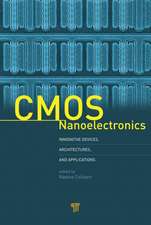Failure Modes and Mechanisms in Electronic Packages
Autor P. Singh, Puligandla Viswanadhamen Limba Engleză Hardback – 30 noi 1997
| Toate formatele și edițiile | Preț | Express |
|---|---|---|
| Paperback (1) | 986.75 lei 6-8 săpt. | |
| Springer Us – 24 oct 2012 | 986.75 lei 6-8 săpt. | |
| Hardback (1) | 938.22 lei 6-8 săpt. | |
| Springer Us – 30 noi 1997 | 938.22 lei 6-8 săpt. |
Preț: 938.22 lei
Preț vechi: 1144.16 lei
-18% Nou
Puncte Express: 1407
Preț estimativ în valută:
179.64€ • 187.06$ • 149.05£
179.64€ • 187.06$ • 149.05£
Carte tipărită la comandă
Livrare economică 14-28 februarie
Preluare comenzi: 021 569.72.76
Specificații
ISBN-13: 9780412105913
ISBN-10: 0412105918
Pagini: 370
Ilustrații: XXI, 370 p.
Dimensiuni: 155 x 235 x 26 mm
Greutate: 0.7 kg
Ediția:1998
Editura: Springer Us
Colecția Springer
Locul publicării:New York, NY, United States
ISBN-10: 0412105918
Pagini: 370
Ilustrații: XXI, 370 p.
Dimensiuni: 155 x 235 x 26 mm
Greutate: 0.7 kg
Ediția:1998
Editura: Springer Us
Colecția Springer
Locul publicării:New York, NY, United States
Public țintă
ResearchCuprins
1 Introduction.- 1.1 The Technology.- 1.2 Packaging Failure.- 1.3 Approach and Methodology.- 1.4 Packaging Hierarchy.- 1.5 Failure Detection.- 1.6 Analysis.- 1.7 Modes and Mechanisms.- 1.8 Physics of failure and statistical models.- 1.9 Prevention.- 1.10 The Future.- 1.11 Suggested Readings.- 2 Electronics Packaging.- 2.1 Introduction.- 2.2 Packaging Nomenclature.- 2.3 Package Function.- 2.4 Plated-Through-Hole and Surface Mount Technology.- 2.5 Chip Level Packaging.- 2.6 Printed Circuit Board Assembly.- 2.7 Connectors, Cables, and Sockets.- 2.8 Box Level Package.- 2.9 Cost of Failures.- 2.10 Summary.- 2.11 Suggested Readings.- 2.12 References.- 3 Why Failures Occur.- 3.1 Introduction.- 3.2 Stress vs. Strength.- 3.3 Poor Design Practices.- 3.4 Manufacturing Defects.- 3.5 Electrical Design Considerations.- 3.6 Material Characteristics.- 3.7 Summary.- 3.8 References.- 4 Failure Detection.- 4.1 Introduction.- 4.2 Analytical Modeling.- 4.3 Simulation.- 4.4 Environmental Stress Tests.- 4.5 Test Methodology Innovations.- 4.6 Summary.- 4.7 Suggested Readings.- 4.8 References.- 5 Failure Analysis.- 5.1 Introduction.- 5.2 Visual Inspection.- 5.3 Decapsulation.- 5.4 Moiré Interferometry.- 5.5 Dye Penetrants.- 5.6 Metallurgical Analysis.- 5.7 Chemical Analysis.- 5.8 Atomic Absorption Emission Spectroscopies.- 5.9 UV/Visible Spectroscopy.- 5.10 Infrared Spectroscopy.- 5.11 Thermoanalytical Methods.- 5.12 Chromatography.- 5.13 Electron Beam Analysis.- 5.14 Laser Induced Ionization Mass Spectrometry (LIMS).- 5.15 Summary.- 5.16 Suggested Readings.- 5.17 References.- 6 Failure Modes and Mechanisms.- 6.1 Introduction.- 6.2 Failure Mode Types.- 6.3 Printed Circuit Board.- 6.4 Components and Packages.- 6.5 Interconnection Failures.- 6.6 Lead-Free Solders.- 6.7 Corrosion and Migration.-6.8 Connector Failures and Mechanisms.- 6.9 Solder Fatigue and Creep.- 6.10 Failures in Nonsemiconductor Components.- 6.11 Electro Static Discharge (ESD) Failures.- 6.12 PCB Laminates and Hollow Glass Fibers.- 6.13 Radiation-Induced Failures.- 6.14 Summary.- 6.15 Suggested Readings.- 6.16 References.- 7 Failure Models.- 7.1 Introduction.- 7.2 A Survey of Physical Models.- 7.3 Physics-of-Failure Based Models for Devices.- 7.4 Accelerated Factors and Transforms.- 7.5 Summary.- 7.6 References.- 8 Failure Prevention.- 8.1 Introduction.- 8.2 Concurrent Engineering and DFM.- 8.3 DFM Examples.- 8.4 Design for Assembly.- 8.5 Design for Test.- 8.6 Design for Qualification.- 8.7 Design for Reliability.- 8.8 Continuous Improvement Through Defect Management.- 8.9 Summary.- 8.10 References.












